Fluctuation of Air Radiation Dose Rate
Influence with the natural radioactive material included in the earth
-
Influence by quality of soil and the topography
In the soil, it is included a very small amount uranium, thorium, radium, and potassium which are natural radioactive material. Therefore, even in states of nature, radiations are always emitting from an earth surface. As the quantity of the natural radioactive material included in the soil varies according to quality of soil, the normal value of air radiation dose observed at the monitoring station is different in each location.
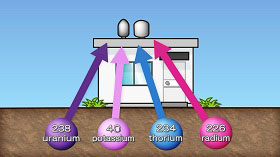
-
As the soil of granite generally includes a lot of natural radioactive material, as for Fukui Pref. the normal value in the area around Tsuruga Peninsula is about 60 nGy/h, which is rather high than other area.
On the other hand, in the area of slate and andesite, such as Ooi or Takahama, the natural radioactive concentration in the soil is lower, and lower value around 30 nGy/h is detected.
As the influence of the outskirts soil for the observation is considerably big, a change may occur in the level of the radiation when the soil close to the monitoring station (within a radius of dozens of meters) is replaced by public works.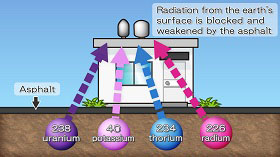
-
Also, if the area around the monitoring station is paved by asphalt, the level of radiation is lower in general because it shuts out the radiation from the earth.
Moreover, measurements may rise under influence by the topography, such as, if the area is close to the sloping land like mountains, radiation doses entering the detector from the slope may increase.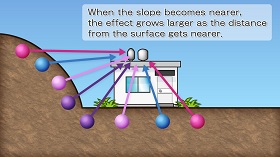
Influence with the natural radioactive material included in the air
-
Radioactive material also exists in the atmosphere around us, though it is a very small amount, in the form of gas or the solid (fine particles). The representative nature radioactive material existing in the air is radon-222.
Radon occurs as a result that natural uranium-238 existing in the soil has been disintegrated for a long period of time. As radon is gas, it gradually leaks out from the underground into the atmosphere. Although radon-222 is supplied from the underground continuously, the equilibrium is kept because it becomes extinct in the half-life of 3.8 days and concentration in the air is held almost constant according to the location.
On the other hand, radioactive materials in the air (fine particles) are mainly nuclides generated by being disintegrated (radon daughter). As a half-life of radon daughter is short (even if a longer one, around 30 minutes), it changes the figure in sequence in a short time, emitting radiation.
As the condition of the radioactive material, such as radon or radon daughter included in the air may change according to the weather condition, it is the main factor of the natural change of the air radiation dose.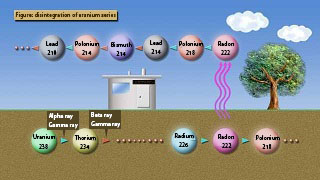
-
Increase in air radiation dose caused by the rain
Fine particles of the radon daughter generated from radon-222 are distributed widely over the sky by the atmospheric convections such as ascending air currents. However, when it rains, they attach to a raindrop and fall into the surface of the earth. As a result, air radiation dose observed on ground increases and may surpass 0.1μGy/h (μSv/h).
As half-life of the radon daughter is around 30 minutes, after rain stopped, the most of them become extinct and return to the usual level of the air radiation dose in around two hours.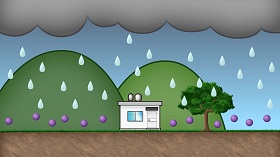
-
Increase in air radiation dose caused by radon daughter
Also, if the area around the monitoring station is paved by asphalt, the level of radiation is lower in general because it shuts out the radiation from the earth.
Moreover, measurements may rise under influence by the topography, such as, if the area is close to the sloping land like mountains, radiation doses entering the detector from the slope may increase.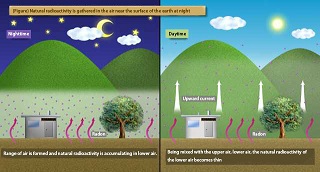
The fluctuation by the season
As the moisture in the soil changes by a season, the air radiation dose rate level may differ as much as several nGy/h. Specifically, when fine weather continues in summer and moisture in the soil decreases, the air radiation dose rate increases. As the area like Fukui, where faces the Japan Sea, has a lot of snow and rain in winter, moisture in the soil increases and the air radiation dose rate decreases.
This phenomenon is caused by moisture of the ground absorbing a radiation from the earth.
Moreover, in winter, when the radiation from the earth is blocked by the snow, air radiation dose rate may decrease temporarily.